Art, Antiques and a Victorian Lady
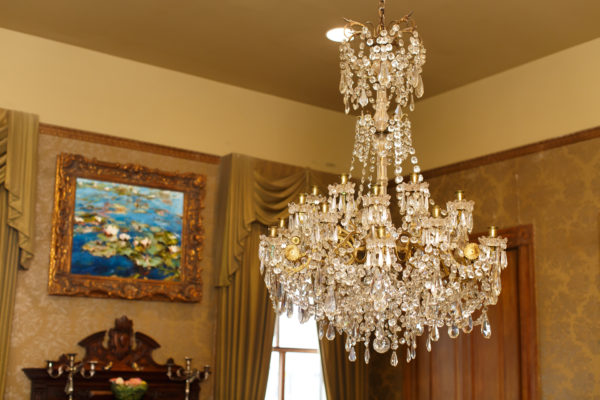
2026 WINTER ANTIQUES & DESIGN SHOW, JANUARY 22-25 | 2026 SPRING ANTIQUES & DESIGN SHOW, MARCH 14 – 28
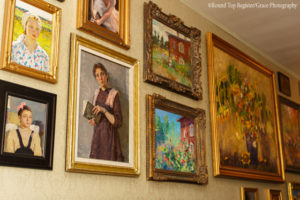
For almost 25 years, Tom Vining and Dent Beall have collected antiques and fine art. In 2015, they found a permanent home for their extensive collection—a tri-colored Victorian lady built in 1887 that is a work of art in her own right.
“When I first saw the exterior, I thought I’d found a home,” Vining said. “But when I walked inside, I knew I’d found a home.”
Beall’s reaction when he toured the home the next day confirmed it.
“Dent came in the front door, and his jaw literally dropped,” Vining said. “We had never really considered Colorado County as our life’s destination, but then we found her.”
For more than 12 years, the partners had split their time between Houston, where Vining co-owns a seven-doctor veterinary practice and Beall is a CPA, and a historic home in Fayetteville. Their collection had outgrown the space. The lot size made it impossible to expand that home to more than 2,900 feet, which fell far short of their requirements. They shopped in Fayette and Washington counties, but nothing met their needs. They even considered relocating to The Heights in Houston.
“The Heights is a great neighborhood, but we had grown to love country living and its sense of community,” Vining said. “Our social life was out here—gallery openings, fundraisers, concerts and dinner parties. Plus, our money went a lot further in rural Texas, and we have elbow room. It was simply meant to be.”
The home was built by Hans and Ida Ilse. Hans, at 16, had emigrated from Germany to Frelsburg in 1856. Ida’s family had arrived in 1847, settling briefly in Houston after her father succumbed to yellow fever, but eventually making their way to the family’s promised homestead in Frelsburg.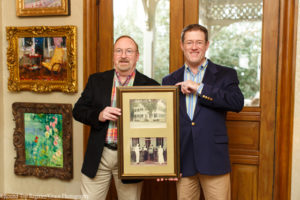
The couple married after Hans returned from fighting for the Confederacy in the Civil War. Seeing opportunity in a larger community, they moved from Frelsburg and built a successful farming, ranching and saloon-keeping enterprise. They had 10 children, seven of whom survived to adulthood.
The home remained in the Ilse family until 1965 when it was sold to the Rau family. Since then the home has changed ownership three more times, making Vining and Beall the fifth owners in 130 years.
“We don’t take the history or the responsibility that comes with the ownership of this grand, old house for granted,” Vining said. “Now it’s our turn to help ensure that it survives for the next generation, whoever that may be.”
The Ilses built the home to last. With the exception of the floors and the interior woodwork, which are pine, the 4,600-square-foot home is constructed entirely from cypress, a wood known for its durability. Cypress is hard, heavy, impermeable and insect-resistant.
“The interior walls are covered with sheetrock, but I regularly break nails when I start to hang paintings,” Vining said. “They hit the cypress and just snap.”
Even after 13 decades, the house is solid. It has withstood several hurricanes including one in 1909 dubbed the Velasco Hurricane that wreaked havoc across Colorado County. Somewhere along the way a strong storm destroyed the railing that once surrounded the widow’s walk on the roof, but sitting on the front balcony looking over the town or standing on the back balcony peering over the grounds there is no give or sway. The stairs and floors don’t creak. Inside the thick walls and antique glass muffle the noise from passing cars.
“In the midst of our move, I spent the first night in the house alone,” Vining said. “It was so quiet. There were no creaks, groans or house noises to get used to because the house just doesn’t move. If there were ghosts here, as so many people jokingly intimate, the spirits are quite content with what we’ve done.”
According to those who know, the house is “a fine example of symmetrical Victorian architecture reminiscent of the Greek Revival period.” The gracious, simple design features wide halls, a formal staircase as well as a back staircase, three marble fireplaces and the warmth of handcrafted woodwork. The molding showcases grained painting, a Victorian-era decorative art.
There are 13 transoms, and 11 of them still function. The highly patterned bronze doorknobs and hinges are original to the house. A total of 11 original chandeliers, including eight crystal, two gilt wood and one wrought iron, add sparkle.
“The chandelier that hangs in the formal dining room isn’t electrified,” Vining said. “One of the couples who previously owned the house burned candles in it every time they hosted dinner parties. We’re still trying—somewhat unsuccessfully—to clean off the wax.” (These days when Vining and Beall entertain they use battery-powered “candles” in the chandelier to give the same effect without the drippy mess.)
Thanks to more than 50 windows, ranging in size from 2.5 feet x 9 feet to 5 feet x 14 feet, and ceilings that soar to 12 feet upstairs and 14 feet downstairs, the historic home is light and airy. Despite the widely held stereotype about older homes, there is nothing dark, dank, dusty or doily-covered about the space. In fact, so much natural light illuminates the walls that Vining only has six art lights in the house that currently accommodates more than 200 paintings.
“One of the first things that struck me about this house was its volume,” Vining said. “Because of its tall ceilings, expansive walls and all of the natural light, the house is even more than the sum of its parts, especially when it comes to being a showcase for antiques and art. I knew immediately that our collections could fill it—and fill it well.”
The Art of Antiques Vining, a Houston native, is the passionate force behind the couple’s art and antiques collections; Beall, who appreciates both art and antiques, collects rare books. The impetus behind all of the collections is a respect for the past and an awareness that fine things should be preserved for the future.
“My dad liked art, but we never had anything of high quality,” Vining said. “As I look back, our family things seemed disposable. I wanted to build my life around well-made things that transcend time because of their quality and beauty.”
Asking Vining whether the art or antiques came first is like asking a rooster whether the front runner was the chicken or the egg. They’ve always just been. From an antiques perspective, Vining’s collection was initially guided by a time period, 1860 – 1880 to be exact. His preferred style: Rococo. His preferred wood: rosewood. His preferred country of origin: America. This combination, while exquisite, is fairly rare.
“Rosewood is a Brazilian wood that is both hard and brittle, which makes it especially hard to carve,” Vining said. “Rococo style features finely carved, asymmetrical ornamentation. Generally, American furniture makers embraced a simpler style than their European counterparts. To find an elaborately carved, American-made rosewood piece that has survived intact for at least 130 years is something quite special.”
His collection includes a variety of furniture that fits this bill including a six-piece parlor set in the Abraham Lincoln pattern, but the piece that consistently makes his eyes light up is an 1863 Steinway Rococo rosewood grand piano.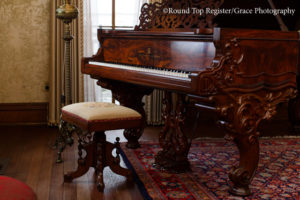
“I saw the piano at auction and had heart palpitations,” Vining, who is also a pianist, said. “I tried to talk myself out of a very major purchase, but for a guy who collects 1860s Rococo rosewood furniture it had everything. Sometimes a piece is your destiny.”
While American rosewood anchors the antiques collection, there are pieces from England, France, Scotland, Germany and Spain. Mahogany, walnut, Carpathian maple, (the European cousin to American birdseye maple) and even humble oak exist in the harmonious hardwood forest of furniture.
The furniture, like the house which showcases it, is built to last. It’s solid hardwood with doors, drawers and side panels that oftentimes are two – three inches thick. The Carpathian maple veneer on a circa 1850 European chest is more than one-half inch thick, unlike early 20th Century birdseye maple veneer that is measured in fractions of fractions of an inch.
“To say these pieces are heavy is an understatement,” Vining said.
Historically, homes were taxed on the number of rooms. Closets counted as rooms, so older homes generally lack the storage space of their modern counterparts. The original residents used large-scale furniture to store their belongings. As a result, Vining has quite a collection of chests, cabinets and armoires for form and function.
When Vining and Beall were moving into the house, they brought their furniture from Fayetteville as well as pieces from Houston. In his mind’s eye, Vining knew where he wanted every piece placed in their new home.
The moving process took four days and involved seven men, who tipped the scales at more than 200 pounds apiece, plus Vining and Beall. At the conclusion, there was only one piece in the entire collection that didn’t fit where Vining envisioned it.
The rebel? A French walnut armoire that stands 9.5 feet tall and measures 75 inches across. It was destined for the master bedroom upstairs, but now resides downstairs in the back living room.
“It took seven men just to lift it,” Vining said. “As we struggled to get it up the stairs, I was afraid we were going to either damage the piece or the house, so I decided to leave it on the first floor.”
Much of the furniture is museum-quality, but the couple lives with it and on it. They laugh good naturedly about friends who come in and walk around with their hands behind their backs like children instructed to look but not touch.
Recently, they hosted a party which they planned to hold in the backyard, but a steady downpour changed their plans. They had 80 people seated throughout the house on rare antiques eating Mexican food and drinking red wine.
“It’s our home. They’re our friends,” Vining said. “Home and friends go together.”
The Artist Collection Soon after they settled into the house, Vining and Beall invited a previous owner over to look at how they had built on her legacy. She is the matriarch of the second family who owned the home and lived in it for 25 years. Vining asked what she liked best about the house.
“Without hesitation, she replied, ‘The art,’” he said. “Because she is a former antiques dealer who is passionate about fine furniture and restoring old homes, it surprised me that she chose the art as the high point. Of course, though, original art breathes life into a space.”
Initially, Vining, who is an active patron of Arts for Rural Texas in Fayetteville and the Live Oak Art Center in Columbus, collected work by local artists. He gravitated toward artists who work in oils using a strong color palette to capture landscapes and still lifes where flowers play a central role. As his collection began to take shape and reflect his taste, the local artists introduced Vining to the work of the Ukrainian impressionists, most notably Sergai Bongart.
“Sergai Bongart left Russia in the aftermath of World War II with 12 canvases under his arms to escape government control of artists’ self-expression,” Vining said.
In 1948, Bongart made his way to the United States where he eventually settled in Rexburg, Idaho because it reminded him of Kiev. He continued to produce art while teaching both serious art students and Hollywood celebrities.
“The idea that someone would risk his life for creative freedom intrigued me as did the opportunity to see how he expressed himself differently than the artists who remained in Russia and eventually worked under Soviet control,” Vining said.
As Vining began to seriously collect Bongart’s works, he also sought the work of the master’s “disciples,” students who lived and worked alongside Bongart. Bongart’s last apprentice before he died was Don Sahli, a West Texan, who studied with Bongart for three years. Vining began acquiring Sahli’s work. Last year Sahli spent three days with Vining and Beall at their home.
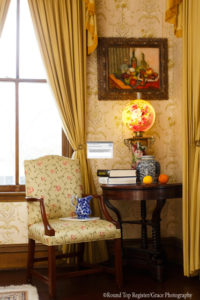 Sahli set up a still life using elements in the couple’s reading room. He painted the scene on-site. The painting now hangs in the same room opposite the chair, table and decorative objects it features.
Sahli set up a still life using elements in the couple’s reading room. He painted the scene on-site. The painting now hangs in the same room opposite the chair, table and decorative objects it features.
Sahli credited Bongart with “teaching me to see like an artist,” but considered Sunny Apinchapong Yang, a Chinese artist who was Bongart’s lead teaching assistant for the last five years of the master’s life, with “teaching me to paint.” Yang is a figure painter, and Vining has amassed a collection of his work that completes the circle between the three artists.
In addition, Vining has acquired the work of Fedor Zakharov, another Ukrainian master, and his followers as well other impressionists residing in the United States. Most recently, he has begun collecting select works by artists who remained in the Soviet Union and worked under Communist constraints.
“My collection allows me to compare and contrast,” Vining said. “It allows me to see the progression and influence of individual painters as well as the stories their work tells as a whole. Primarily, though, it brings me joy.”
Vining had a singular vision for the placement of the paintings just as he did with the placement of the furniture. He, with help, has hung every piece. Art graces the walls in every room, but the largest concentration of paintings lines the wall alongside the front staircase.
To hang the art on the second story required the couple to construct their own scaffolding from 2 x 12s and plywood. It had to be strong and steady enough to hold two people on ladders over the void of the stairwell, which is 16 feet across with a depth of up to 20 feet.
“It took two hours to build the scaffolding, an hour to hang the paintings and two hours to take it all apart,” Vining said. “Nobody even got close to dying.”
Even to the untrained eye, the result is stunning. Defying logic, the mass of paintings are not a visual assault. While each piece is a unique expression, the themes, styles, techniques and color palettes create a unified whole that invites the viewer to look carefully and savor the nuances. It’s an experience that extends throughout the entire house. As the light changes over the day’s course, so does the character and impact of each painting. It’s a never-ending parade for the senses.
“Every morning that I wake up in this house, I’m awed by the gift of its beauty,” Vining said. “Every day is a chance to savor the familiarity of each piece—and an opportunity to discover something new.”
Tom’s Top Five Tips for Beginning Antiques Collectors
Tom’s Top Seven Tips for Beginning Art Collectors
by Lorie A. Woodward
photos by Anna Spencer Morse, Grace Photography
2026 WINTER ANTIQUES & DESIGN SHOW, JANUARY 22-25 | 2026 SPRING ANTIQUES & DESIGN SHOW, MARCH 14 – 28
